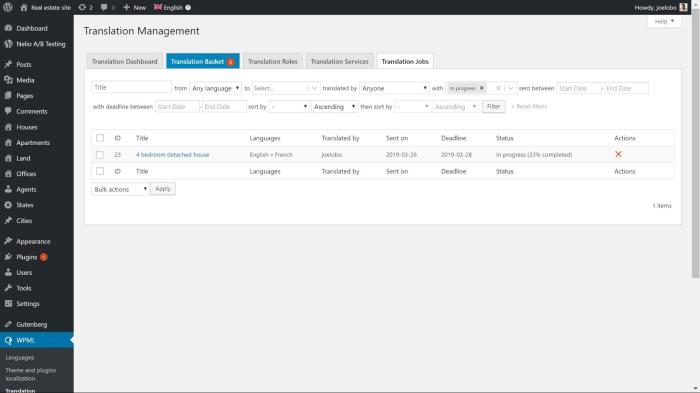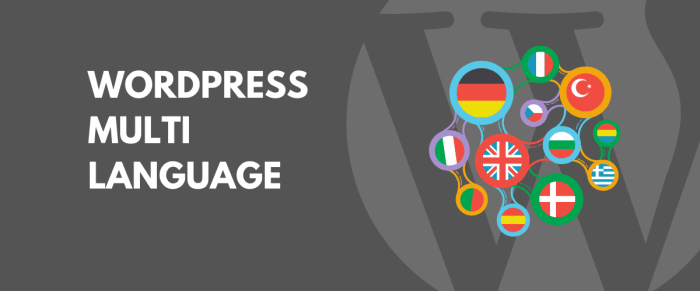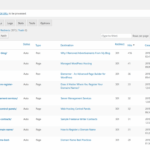Create a multilingual WordPress website to reach a global audience. This comprehensive guide covers everything from planning and setup to content creation, design, testing, and maintenance. We’ll explore the essential features, plugins, and best practices to ensure your website is accessible and successful in multiple languages.
From choosing the right WordPress plugins to crafting culturally sensitive content, this guide will equip you with the knowledge and strategies needed to build a multilingual WordPress website that truly connects with a worldwide audience. We’ll delve into the nuances of website localization and , ensuring your site performs well in international searches.
WordPress Setup & Configuration

Setting up a multilingual WordPress website involves more than just translating text. Careful planning and configuration are crucial for a seamless user experience and effective search engine optimization. This process ensures your website is accessible and appealing to a global audience.A well-structured multilingual WordPress site allows users to navigate the content in their preferred language, significantly improving user engagement and satisfaction.
This setup ensures your website resonates with a wider audience, fostering international growth and expansion.
WordPress Installation for Multilingual Sites
The installation process for a multilingual WordPress site is essentially the same as for a single-language site. Download the WordPress files, upload them to your web hosting account, and follow the on-screen instructions. However, remember that you will need to install a multilingual plugin later in the process.
Multilingual Plugin Installation and Configuration
Choosing and installing a suitable multilingual plugin is critical for your site. Popular choices include WPML, Polylang, and Loco Translate. Follow the plugin’s instructions for activation and configuration. This includes selecting the target languages, setting up translation management, and assigning translations to specific content. Careful configuration is vital for a seamless user experience.
Website Localization Methods
Localization strategies extend beyond simply translating text. They involve adapting content to specific cultural contexts. Consider cultural nuances, local customs, and legal requirements when translating. This includes adapting units of measurement, dates, and times to local standards. Additionally, ensure that images, graphics, and other media are appropriate for the target audience.
Choosing the Right Domain Name for Multilingual Use
A well-chosen domain name can significantly impact your multilingual website’s success. Consider using a domain name that is easy to remember and spell in multiple languages. This reduces confusion and improves brand recognition. Also, investigate if the domain name is available in your target languages. A descriptive or -rich domain name is ideal.
Handling Multilingual Menus and Navigation
Properly structuring multilingual menus and navigation is essential for user experience. A well-designed multilingual menu system ensures users can easily switch between languages and locate the content they need. Use a clear and consistent menu structure across languages. Navigation should be intuitive and user-friendly, regardless of the selected language.
Website Speed Optimization in Multilingual Environments
Website speed is crucial for user satisfaction, especially in multilingual environments. Translation files and the handling of multiple language options can impact loading times. Optimize images, use a Content Delivery Network (CDN), and minify code to improve performance across different languages. Utilize caching plugins and techniques to improve page load speeds for all visitors.
Creating a multilingual WordPress website opens up a world of possibilities, but a crucial part of its success is having a compelling landing page. To make the most of your multilingual site, you need to craft a landing page that effectively targets each language audience. This involves understanding your audience’s needs and using clear, concise language in each translation.
A well-designed landing page is key, and learning how to build one effectively is essential. Check out this helpful guide on how to build a landing page for tips and tricks on crafting a winning page for your multilingual WordPress website.
Multilingual WordPress Plugins: A Comparison
Different plugins cater to various needs and budgets. A comparative table can help you choose the right one.
| Plugin | Pros | Cons |
|---|---|---|
| WPML | Extensive features, robust support, large community. | Can be expensive, more complex setup. |
| Polylang | User-friendly interface, relatively affordable. | Fewer advanced features compared to WPML. |
| Loco Translate | Lightweight, suitable for simple translations, free. | Limited advanced features, less robust support. |
Choosing the right plugin depends on your specific requirements, budget, and technical expertise.
Creating a multilingual WordPress website can be a great way to reach a wider audience, but understanding user engagement is key. Factors like the average time spent on each page, as measured by average time on page google analytics , will help you optimize content and design for better user experience. Ultimately, this translates to a more effective and engaging multilingual website for your target audience.
Content Creation & Translation
Creating a multilingual website is more than just translating text. It requires a deep understanding of different cultures and languages to ensure your message resonates with your target audience. This involves careful planning, meticulous execution, and a commitment to quality throughout the entire process. The key is to approach content creation as a holistic strategy that encompasses both the linguistic and cultural aspects of each target market.A multilingual website, effectively designed and executed, can significantly enhance your global reach and foster stronger connections with international customers.
By embracing diverse languages and cultures, you demonstrate respect and understanding, fostering trust and loyalty.
Best Practices for Multilingual Website Content
Creating multilingual content requires a systematic approach. This involves thorough planning, meticulous execution, and a commitment to quality throughout the process. High-quality multilingual content is essential for establishing a strong online presence in diverse markets. It builds trust and fosters positive interactions with users from various backgrounds.
- Thorough Research: Conduct comprehensive research for each target language. This ensures your content is discoverable by users searching in those languages. Understanding local search patterns is critical for optimal visibility.
- Content Planning and Structuring: Develop a structured content plan for each language. This ensures consistency and coherence across all versions. A well-structured content plan streamlines the translation process and maintains a consistent user experience.
- Focus on Clarity and Simplicity: Prioritize clear and concise language. Avoid jargon or overly technical terms that might be unfamiliar to users in different regions. Simplicity and clarity improve comprehension across diverse language and cultural backgrounds.
- Utilizing a Consistent Tone and Voice: Maintain a consistent tone and voice across all translated content. This reinforces brand identity and creates a cohesive experience for users. Consistency in voice and tone builds brand recognition and fosters user familiarity.
Strategies for Efficient Content Translation
Efficient translation requires careful planning and the selection of appropriate tools and resources. Effective strategies ensure quality, speed, and cost-effectiveness.
Creating a multilingual WordPress website can be a rewarding experience, but if you’re having trouble getting your site indexed by Google, you might want to check out this helpful resource on ask an SEO why is Google not indexing my pages. Proper SEO is crucial for any website, especially when targeting multiple languages. Once you’ve nailed the technical aspects, you’ll be well on your way to a successful multilingual WordPress site.
- Using Professional Translation Services: Employ professional translators with expertise in both the source and target languages. This ensures accuracy and cultural appropriateness. Using professionals safeguards against errors and ensures the cultural nuances are accurately conveyed.
- Employing Translation Memory Tools: Leverage translation memory (TM) tools to store and reuse translated segments. This accelerates the process and ensures consistency. These tools improve efficiency by reusing translated segments, reducing redundant work.
- Implementing a Collaborative Translation Workflow: Establish a clear and efficient workflow for translation. This may involve assigning tasks, setting deadlines, and implementing quality checks. A collaborative workflow ensures a streamlined and efficient process.
Cultural Sensitivity in Multilingual Content
Cultural sensitivity is paramount in multilingual content creation. It ensures that the content resonates with the target audience on a deeper level. Respecting cultural nuances builds trust and fosters positive interactions.
- Understanding Cultural Nuances: Research and understand cultural nuances in each target market. This includes customs, traditions, and values. Understanding cultural nuances is essential for tailoring content to resonate with specific audiences.
- Adapting Content for Cultural Context: Adapt content to reflect the cultural context of each target market. This includes using appropriate terminology, imagery, and examples. Tailoring content to specific cultural contexts is crucial for effective communication.
- Avoiding Stereotypes and Bias: Avoid stereotypes and biases in all content. Ensure all messaging is inclusive and respectful. Creating inclusive and respectful content builds trust and avoids misunderstandings.
Comparison of Translation Tools and Services
Numerous translation tools and services are available. Selecting the right one depends on specific needs and budget.
- Machine Translation Tools: Machine translation (MT) tools can offer rapid translations, but their accuracy may vary. MT tools can be useful for initial drafts but often require human review and editing.
- Professional Translation Agencies: Professional translation agencies offer experienced human translators and specialized services. Agencies provide expertise and ensure accuracy, often offering customized solutions to address specific requirements.
- Freelance Translators: Freelance translators can provide cost-effective solutions for smaller projects. Choosing freelancers necessitates careful vetting and review to ensure quality.
Different Content Types Required for a Multilingual Site
Multilingual websites require a variety of content types to cater to different user needs. A diverse range of content types enhances user engagement and ensures a seamless experience.
- Website Pages: Translate all website pages, including home pages, about pages, contact pages, and product pages. Ensuring all website pages are translated ensures all information is accessible to a global audience.
- Blog Posts: Translate blog posts to engage users in different languages. Blog posts are an excellent way to attract and engage users in different markets.
- Product Descriptions: Translate product descriptions to highlight features and benefits in different languages. Translating product descriptions helps showcase the value proposition to diverse markets.
- Contact Forms: Translate contact forms to enable communication with users in their native language. Making contact forms accessible in different languages enhances user engagement and promotes international outreach.
Multilingual Content Creation: Key Aspects
| Aspect | Description |
|---|---|
| Language Accuracy | Ensuring the translated text accurately conveys the intended meaning and tone of the original content. |
| Cultural Sensitivity | Adapting the content to reflect the cultural context and norms of the target audience. |
| Consistency | Maintaining a consistent tone, style, and brand voice across all translated content. |
| Accessibility | Ensuring the content is accessible to users with disabilities, regardless of their language. |
| Optimization | Optimizing the translated content for search engines in the target languages. |
Website Content Quality Assurance Checklist
Ensuring high-quality content across multiple languages is crucial for a successful multilingual website. A rigorous quality assurance process helps ensure the translated content meets the highest standards.
- Verification of Translation Accuracy: Verify that the translation accurately reflects the original message.
- Cultural Appropriateness Review: Ensure the translated content is culturally appropriate for the target audience.
- Consistency Check: Verify that the translated content maintains a consistent tone and voice across all pages.
- User Testing: Conduct user testing to ensure the translated content is easy to understand and use.
Technical Aspects
Choosing the right hosting provider is crucial for a multilingual website’s performance and reliability. A provider with robust infrastructure, good support, and appropriate bandwidth is essential to handle the increased traffic and data demands associated with multiple languages. This is especially important for websites expecting significant multilingual traffic or engaging in content localization efforts.A multilingual website presents a unique attack surface for malicious actors.
Robust security measures are paramount, extending beyond standard WordPress security practices. This includes regular security audits, strong password policies, and implementation of a robust firewall to protect against DDoS attacks and other threats.
Choosing a Suitable Hosting Provider
A suitable hosting provider for a multilingual website needs to offer more than just basic hosting. Consider factors like server location, which should be geographically close to your target audience to minimize latency. Also, look for hosting providers specializing in high-traffic websites and ensuring adequate bandwidth to accommodate language-specific content downloads. Ensure they offer reliable uptime and excellent customer support, particularly crucial when dealing with technical issues related to multilingual setups.
Secure Website Practices
Implementing secure website practices is paramount for a multilingual website, given the potential increase in attack vectors. Regular security audits, including vulnerability scans, help identify and address potential security holes. Strong password policies and two-factor authentication are essential to protect user accounts and sensitive data. Implementing a robust firewall, specifically designed for multilingual websites, protects against DDoS attacks and other malicious activities.
Managing Multilingual Databases
Managing multilingual databases involves careful planning and execution. WordPress multilingual plugins often employ techniques like storing language-specific content in separate tables or using language-tagged columns within a single table. Understanding how the chosen plugin handles database structure is crucial to avoid potential performance bottlenecks or data corruption. Thorough testing in a staging environment is vital before deploying any changes to the production database.
Robust Caching Systems
A robust caching system is essential for a multilingual website. It reduces the load on the database and servers, leading to faster page load times for users. A caching system can cache language-specific content separately, or combine multilingual content in a single cache entry based on the user’s language preference. This can dramatically improve the user experience and overall website performance, especially for websites with large amounts of translated content.
Comparing Security Plugins
Different security plugins offer varying features and capabilities. Some are tailored for general WordPress security, while others are designed to handle specific multilingual website security concerns. When selecting a plugin, consider its ability to manage user roles and permissions in a multilingual environment, as well as its integration with the chosen multilingual plugin. Thoroughly research the plugin’s features and reviews to ensure compatibility and efficacy.
Consider factors like the plugin’s performance impact and ease of use.
Essential Technical Considerations
For multilingual WordPress sites, some essential technical considerations include:
- Content Delivery Network (CDN): Using a CDN can significantly improve page load times for users globally by distributing content closer to their geographic location.
- Database Optimization: Optimizing the database structure and queries is crucial for performance, especially with multilingual content, to avoid performance bottlenecks.
- Internationalization (i18n): Implementing proper internationalization practices ensures the website is accessible and usable by users worldwide.
- Localization (l10n): Localization ensures that the website is culturally relevant and adapted to different target markets.
Potential Technical Issues and Solutions
| Technical Issue | Potential Solution |
|---|---|
| Slow page load times due to large translated content | Employing a robust caching system and CDN, optimizing database queries, and using a content delivery network (CDN). |
| Database corruption due to improper data management | Thoroughly testing any database changes in a staging environment and backing up the database regularly. |
| Security vulnerabilities due to a lack of secure practices | Regular security audits, strong password policies, and two-factor authentication, as well as implementing a robust firewall. |
| Language switching issues or incorrect display of translated content | Double-checking the settings and configurations of the chosen multilingual plugin and ensuring proper language-code implementation. |
User Experience (UX) & Design
A multilingual website’s success hinges on providing a seamless and enjoyable experience for users across all languages. A consistent user experience (UX) is crucial for building trust and encouraging return visits. This involves more than just translating text; it necessitates a thoughtful approach to design, imagery, and accessibility. Effective multilingual design ensures that users in different regions feel welcomed and understood, ultimately boosting engagement and conversions.A well-designed multilingual website considers the diverse needs and preferences of its target audience.
It goes beyond simply translating content, addressing factors like cultural nuances, visual preferences, and language-specific conventions. This proactive approach fosters user confidence and encourages positive interactions with the website.
Importance of Consistent User Experience Across Languages
Maintaining a consistent user interface (UI) across all translated languages is paramount. This consistency ensures that users can intuitively navigate the site, regardless of the language they choose. A predictable layout, clear navigation, and uniform design elements reduce cognitive load and allow users to focus on the content. This creates a sense of familiarity and reduces the likelihood of frustration, which is essential for a positive user experience.
Impact of Design Elements on Multilingual Website Usability, Create a multilingual wordpress website
Design elements profoundly impact the usability of a multilingual website. Color palettes, typography, and imagery need to be carefully considered. Cultural associations with colors and fonts vary across languages, and using appropriate choices can enhance user engagement. For example, a color that evokes a positive feeling in one culture might have a different connotation in another. This careful selection of design elements ensures that the site resonates with the target audience in each region.
Strategies for Creating Accessible Multilingual Designs
Creating accessible multilingual designs involves several key strategies. Using clear and concise language, providing alternative text for images, and implementing keyboard navigation are crucial for users with disabilities. Furthermore, ensuring proper character encoding and avoiding language-specific layout issues is essential. A well-structured website architecture that facilitates navigation regardless of language choice contributes significantly to the site’s accessibility.
Localizing Website Imagery and Graphics
Localizing website imagery and graphics is crucial for effective communication. Cultural appropriateness should be prioritized. Images used should resonate with the target audience and avoid any potential misinterpretations or offense. For instance, using culturally relevant imagery in advertisements or product demonstrations can significantly improve the effectiveness of the campaign. Additionally, utilizing high-quality images that are optimized for web use is important for a positive user experience.
Examples of Effective Multilingual Website Designs
Numerous websites exemplify effective multilingual design. For example, successful websites often use a language switcher that is prominently displayed, allowing users to easily change languages without difficulty. They also ensure that the website structure is consistent, maintaining a similar navigation experience in all languages. Another important element is the use of culturally appropriate imagery and visual elements.
Ensuring a Seamless User Experience for All Languages
Ensuring a seamless user experience requires a multifaceted approach. The design must support all languages, including those with complex scripts. The website’s layout must be responsive, adapting to different screen sizes and devices. Clear and consistent navigation menus, along with readily available translation tools, are also critical elements.
Website Design Approaches for Multilingual Audiences
| Design Approach | Description | Advantages | Disadvantages |
|---|---|---|---|
| Localized Design | Tailoring the design elements to specific cultural contexts. | Enhanced cultural relevance, improved user engagement. | Increased development time, potentially higher costs. |
| Global Design | Maintaining a consistent design across all languages. | Reduced development time, lower costs. | Potential for reduced cultural relevance, less engagement in certain regions. |
| Hybrid Design | Balancing localized and global elements. | Optimizes the balance between consistency and cultural relevance. | Increased complexity in development and maintenance. |
Testing & Maintenance: Create A Multilingual WordPress Website
Ensuring a smooth user experience across multiple languages requires meticulous testing and ongoing maintenance. A well-maintained multilingual website not only provides accurate and culturally appropriate content but also builds trust and strengthens your brand’s global presence. This section details the critical aspects of testing and maintaining a multilingual website to ensure optimal performance and user satisfaction.
Multilingual Website Testing Methods
Effective multilingual testing involves more than just checking for grammatical correctness. It necessitates a multi-faceted approach to guarantee a seamless experience for all users. This includes checking for accurate translations, correct formatting, and functional compatibility across different languages and locales. Comprehensive testing strategies should consider various factors, such as character encoding, rendering issues, and compatibility with different browsers and devices.
Multilingual Website Maintenance Best Practices
Regular maintenance is crucial for a multilingual website’s long-term success. This includes staying updated with the latest WordPress versions, ensuring security patches are applied promptly, and implementing a robust content update strategy. Consistent monitoring for potential issues, such as broken links or incorrect translations, is essential. This proactive approach minimizes downtime and prevents negative user experiences.
Importance of Continuous Updates and Security Patches
Continuous updates and security patches are paramount for multilingual websites. Security vulnerabilities can quickly escalate if not addressed promptly, leading to data breaches and reputational damage. Regular updates not only strengthen security but also improve functionality and enhance compatibility with new technologies. By implementing a consistent update schedule, website owners can safeguard their multilingual platforms.
Common Multilingual Website Issues and Solutions
Common issues in multilingual websites include incorrect translations, broken links, and inconsistent formatting. Addressing these issues proactively is vital for maintaining user trust and avoiding negative perceptions. Identifying the root cause and applying the appropriate solution is key to maintaining a high-quality multilingual website. For example, incorrect translations can be corrected by reviewing and revising the translated content.
Broken links can be fixed by updating the broken links with the correct URLs. Inconsistent formatting can be addressed by using a style guide and ensuring the site’s design is consistent across all languages.
Periodic Multilingual Website Maintenance Checklist
Maintaining a multilingual website requires a structured approach. A checklist helps ensure all necessary steps are completed. This includes verifying translations, checking for broken links, and ensuring website functionality across various devices and browsers. Regular updates and security patches should be implemented promptly.
- Review and update all translated content for accuracy and consistency.
- Verify all links for proper functionality and redirect to the correct pages in each language.
- Ensure website elements are responsive and display correctly across different devices (desktops, tablets, mobile).
- Check for any potential errors or issues in the website’s code and address them promptly.
- Implement and maintain website backups for data recovery purposes.
- Ensure the website’s security by installing and applying the latest security patches.
Translation Update Process
Regular translation updates are essential to keep content current and relevant. This process should be well-defined and documented to ensure consistent quality and accuracy. Establish clear communication channels between the website owner and the translation team to streamline the update process. The procedure should involve content review, translation, and quality assurance steps.
Importance of Multilingual Website Testing
| Aspect | Importance | Example ||—|—|—|| Accuracy | Ensures correct translations, avoiding misunderstandings and misinterpretations. | A product description translated incorrectly could lead to lost sales. || Functionality | Guarantees all website features and functionalities work seamlessly in every language. | A form that doesn’t submit correctly in a particular language can lead to user frustration.
|| Accessibility | Ensures the website is accessible to all users regardless of their language or cultural background. | Visual impairments and other disabilities can be impacted by inconsistent language or design elements. || Cultural Sensitivity | Minimizes potential cultural misunderstandings or offense. | Inappropriate imagery or phrasing in a particular language can damage your reputation.
|| User Experience | Contributes to positive user experiences across all languages. | A website that is difficult to navigate in a particular language can lead to a negative user experience. |
Outcome Summary

Building a multilingual WordPress website is a rewarding experience that opens doors to global markets. By following the steps Artikeld in this guide, you can confidently create a website that’s not only beautiful and functional but also truly accessible to a global audience. Remember, careful planning, effective translation, and a focus on user experience are key to success.






